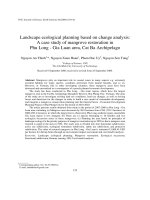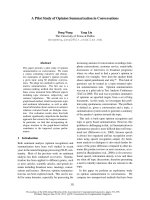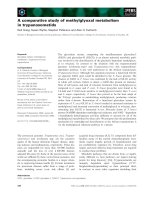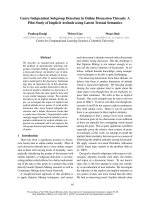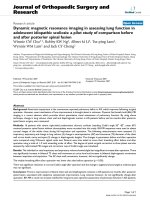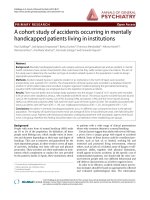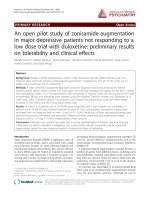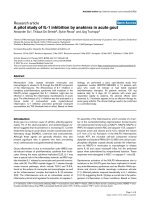A PILOT STUDY OF THE PREVALENCE OF COELIAC DISEASE IN VIETNAMESE PATIENTS WITH GRAVES’ DISEASE
Bạn đang xem bản rút gọn của tài liệu. Xem và tải ngay bản đầy đủ của tài liệu tại đây (5.74 MB, 113 trang )
HONOUR THESIS
A PILOT STUDY OF THE PREVALENCE OF COELIAC DISEASE IN
VIETNAMESE PATIENTS WITH GRAVES’ DISEASE
Khoa Dang Truong, BBMed Sci
207624
Supervisors
Professor Peter R. Ebeling, MD, MBBS, FRACP
Dr Alex Boussioutas, MBBS, PhD, FRACP
Dr Bob Anderson, PhD, FRACP
Thesis submitted to University of Melbourne for the Degree of
Bachelor of Science with Honours
Department of Medicine (RMH/WH)
Monday 27th October 2008
Word Count: 8,969
1
DEDICATION
~ This Honours Research Project and Thesis is dedicated to my Parents ~
In remembrance of my grandfathers Truong Thuong and Le Duc Thanh, both of whom had passed
away with cancers.
~ Their memories will remain with me for as long as I live ~
2
DECLARATION – PAGE 1 OF 2
Department of Medicine (RMH/WH)
DECLARATION BY SCHOLAR
Khoa Dang Truong ........................ (Student’s Name)
I, ..............................................
Certify that
•
The thesis comprises only my original work, except where indicated in the accompanying
Acknowledgement statement *
•
The thesis conforms to the specifications outlined in the Honours Handbook.
Signature: _________________________
Date: _____27/10/2008
________________________
DECLARATION BY PRINCIPLE SUPERVISOR
Khoa Dang Truong ........ (Student’s Name) Thesis is a
I confirm that the declaration above of .........................................
true and fair representation of the student’s work.
Signature: _________________________
23/10/2008 ______________
Date: _______________
*Your Acknowledgement page must declare, as appropriate:
The extent to which the student has used the work of others
The contribution of the student to work carried out in collaboration with others
A description of work submitted for any other qualification
A description of work carried out prior to enrolment in Honours.
3
DECLARATION – PAGE 2 OF 2
Department of Medicine (RMH/WH)
DECLARATION BY 2ND SUPERVISOR
Khoa Dang Truong ......... (Student’s Name) Thesis is a
I confirm that the declaration above of ........................................
true and fair representation of the student’s work.
Signature: _________________________
Date: ______24/10/2008
_______________________
*Your Acknowledgement page must declare, as appropriate:
The extent to which the student has used the work of others
The contribution of the student to work carried out in collaboration with others
A description of work submitted for any other qualification
A description of work carried out prior to enrolment in Honours.
DECLARATION BY 3RD SUPERVISOR
Khoa Dang Truong ......... (Student’s Name) Thesis is a
I confirm that the declaration above of ........................................
true and fair representation of the student’s work.
Signature: _________________________
Date: _______________
27/10/2008 ______________
*Your Acknowledgement page must declare, as appropriate:
The extent to which the student has used the work of others
The contribution of the student to work carried out in collaboration with others
A description of work submitted for any other qualification
A description of work carried out prior to enrolment in Honours.
4
ACKNOWLEDGEMENTS
“Trust in the LORD with all your heart and lean not on your own understanding;
In all your ways acknowledge him, and he will make your paths straight.” ~ Proverbs 3:5-6
In reverence of the Lord God Almighty, I am eternally grateful for His providence, blessings and
faithfulness in all things. Let all glory be to God, forever and ever. Amen.
To my supervisor, Professor Peter Ebeling, thank you for your gentle words, your
understanding and compassion. Your unfathomed wisdom had always remained a mystery to me,
even to this day. Thank you for giving me a chance to follow my dreams and to experience research
that would benefit others. To my co-supervisor, Dr Alex Boussioutas, thank you for your generous
guidance, patience and lenience. Thank you for reminding me the reason why I worked so hard to be
where I am today. You will always have my respect, both as a scientist and a man of his word. To my
co-supervisor, Dr Bob Anderson, thank you for your genuine advice, reassurance and unrivalled
expertise. You were always there for me when there was no one else to turn to. I will always
remember the motivational chats and the meetings over lunch with you. To all three of you, thank you
for making this the best year of my study-life.
To Dr Claudia Gagnon, thank you for the time you have spent, taking me through the ethics
approval process and showing me the statistical analysis. I can never repay you enough for your kind
intentions, and for helping me along every step of the way in my Honours Project this year. To Dr
Anjali Haikerwal, thank you for your references regarding the ranges of Vitamin D deficiency in the
project. To Dr Leo Rando, thank you for your referrals of patients from Endocrinology clinic.
To Sandy Dupuis, thank you for building and managing the database of participants for this
project. Your wonderful ideas and constructive criticisms were necessary and influential in the
arrangements of this project. To Maria Bisignano, thank you for directing the blood tests at Pathology
of Royal Melbourne Hospital. You were so dedicated and thoughtful, which made everything so easy
to overcome. To Margaret Watson, thank you for organising the blood collection at Western Hospital.
Even though you were short on staff, you still maintained an easygoing attitude and tolerance towards
the rapidly increasing number of participants who came for blood test. To Cathy Phillips, thank you
for standing up for me in times of need. Your presence alone, at the Pathology office, had encouraged
5
me to endure through all the tough times. To all the nurses who helped with the blood collection,
thank you for your impressive skills and the ability to work under pressure.
To Marian Croft, thank you for your suggestions regarding the blood tests and patient history.
To Sally Edmonds, thank you for your directions with the online clinical information system. To Jia
Wei Teo, thank you for the transport and storage of the frozen blood samples in this project. To
Vivien Li, thank you for your fluent writing skills that were used to edit my ethics approval forms. To
Lynette Kalms, thank you for general administration and receiving patient phone calls in my absence.
To Fiona Wylie, thank you for your encouragement and warm-hearted smiles. It wouldn’t be the same
without you around the department. To Erin Wijaya Ng, thank you for the initial accommodations of
the project. I wish you all the best in your future career.
To my cousin, Nguyen Tuong Dinh, thank you for your reading of the daily radio
advertisements on Stereo FM 97.4 Vietnamese Radio. Your specialty in radio advertisement had
predisposed the potential participant to participation. To Mr Thai Hoa and Mrs Phuong Hoang from
SBS Vietnamese Radio 122.4 AM, thank you for the valuable time of your interview and daily
advertisement broadcasts. It was terrific to have you communicated our project to the broader
Vietnamese Community. To Dr Hai Phan, from the local clinics, thank you for your referral of
participants and offer to promote our project to the Vietnamese Medical society. To the Vietnamese
Churches and Organisations, thank you for your overwhelming support for this project.
To my Honours friends and fellows DoMSA Committee who have travelled with me on this
journey, thank you for your companionship and your support in my role as Honours Student
Representative this year in 2008. I will never forget the precious time spent together on our Ski Trip,
rock climbing, soccer games, and trivia nights. Thank you all for being part of my life.
To my grandmother, Nguyet Thi Le, thank you for praying to God with tears for me. To aunt
Dung Thi My Truong, thank you for your enthusiasm in contacting friends and neighbours. To my
Father, Luu Vinh Truong; my mother, Hoa Kim Le; and my beloved brothers, Danh Cong Truong,
Long Kim Truong and Thomas An Thien Truong. Thank you. You are the reason why I am here.
To all Vietnamese participants whose participation had made this Project possible… Thank you!
6
TABLE OF CONTENTS
TITLE PAGE
1
DEDICATION
2
DECLARATION
3
PAGE 1 OF 2……………………………………….………………………………………….3
PAGE 2 OF 2…………………………………………….…………………………………….4
ACKNOWLEDGEMENTS
5
TABLE OF CONTENTS
7
ABSTRACT
10
ABBREVIATIONS
12
1. INTRODUCTION
14
1.1 GRAVES’ DISEASE……………………………………………………………………………...14
1.1.1 Graves’ disease as a Cause of Hyperthyroidism………………………………………..14
1.1.2 The Aetiology of Graves’ disease – Role of Autoimmunity…………………………...14
1.1.3 Genetic Background…………………………………………………………………….15
1.1.4 Prevalence of Graves’ disease………………………………………………………….16
1.1.5 Diagnosis of Graves’ disease…………………………………………………………...16
1.1.6 Current Therapy and Treatment………………………………………………………...17
1.2 COELIAC DISEASE……………………………………………………………………………...17
1.2.1 Coeliac disease as an Autoimmune Disorder…………………………………………...17
1.2.2 The Aetiology of coeliac disease – Disease Mechanism and Cause…………………...17
1.2.3 Genetic Background…………………………………………………………………….19
1.2.4 Prevalence of coeliac disease…………………………………………………………...20
1.2.5 Symptoms and Complications………………………………………………………….20
1.2.6 Diagnosis and Screening………………………………………………………………..21
1.2.7 Current Therapy and Treatment………………………………………………………...22
1.2.8 Consequences of untreated coeliac disease……………………………………………..23
1.3 RATIONALE……………………………………………………………………………………...24
1.3.1 The Link between Graves’ and coeliac disease………………………………………...24
1.3.2 High rate of Vietnamese Graves’ patients at Western Hospital………………………..24
1.3.3 Early Prevention reduces Morbidity, Mortality and other Risks……………………….25
1.3.4 Micronutrient Deficiencies Might Predict coeliac disease……………………………..25
1.3.5 To Establish the Prevalence of coeliac disease in Vietnamese…………………………25
2. AIMS
26
2.1 Hypothesis…………………………………………………………………………………………26
2.2 Primary Aim……………………………………………………………………………………….26
2.3 Secondary Aim…………………………………………………………………………………….26
3. METHODS
27
Ethics Approval………………………………………………………………………………………..27
3.1 PROJECT DESIGN……………………………………………………………………………….27
3.1.1 Study Population………………………………………………………………………..27
3.1.2 Recruitment Strategies………………………………………………………………….27
7
3.1.3 Inclusion Criteria……………………………………………………………………….31
3.1.4 Exclusion Criteria………………………………………………………………………31
3.1.5 Database Establishment………………………………………………………………...32
3.2 PROCEDURES……………………………………………………………………………………32
3.2.1 Initial Screening………………………………………………………………………...32
3.2.2 Study Visit……………………………………………………………………………...32
3.2.3 Biochemical Blood Tests……………………………………………………………….32
3.2.4 Genes Test and Small Bowel Biopsy…………………………………………………...33
3.3 STATISTICAL ANALYSIS……………………………………………………………………...33
3.3.1 Sample size and Selection………………………………………………………………33
3.3.2 SPSS Software Analysis………………………………………………………………..33
3.3.3 Limitations……………………………………………………………………………...34
3.3.4 Potential Source of Bias………………………………………………………………...34
4. RESULTS
35
4.1 Recruitment of Participants………………………………………………………………………..35
4.2 Biochemical Analysis……………………………………………………………………………..35
TABLE I: Baseline Characteristics of the Participants……………………………………….35
TABLE II: Prevalence of coeliac disease by Group………………………………………….36
TABLE III: Prevalence of Vitamin D Deficiency and Insufficiency by Group……………...36
FIGURE 1: Prevalence of Severe, Moderate and Mild Vitamin D Deficiency and
Insufficiency by Group……………………………………………………………………….37
TABLE IV: Prevalence of other Nutrient Deficiencies by Group……………………………37
FIGURE 2: Prevalence of other Nutrient Deficiencies by Group……………………………38
TABLE V: Prevalence of Anaemia, Microcytosis and Macrocytosis by Group……………..38
FIGURE 3: Prevalence of Anaemia, Microcytosis and Macrocytosis by Group…………….39
5. DISCUSSION
40
5.1 Baseline Characteristics…………………………………………………………………………...40
5.2 Prevalence of coeliac disease in Vietnamese Graves’ disease Patients…………………………...40
5.3 Vitamin D Deficiency……………………………………………………………………………..41
5.4 Anaemia in Graves’ disease……………………………………………………………………….42
5.5 Limitations Encountered…………………………………………………………………………..42
5.6 Source of Bias……………………………………………………………………………………..42
6. CONCLUSION
44
7. REFERENCES
45
APPENDIX
i
APPENDIX 1: PARTICIPANT INFORMATION AND CONSENT FORM
English Version…………………………………………………………………………………i
Consent Form………………………………………………………………………………….vi
Revocation of Consent Form…………………………………………………………………vii
APPENDIX 2: PARTICIPANT INFORMATION AND CONSENT FORM
Vietnamese Version………………………………………………………………………….viii
Consent Form………………………………………………………………………………..xiii
Revocation of Consent Form………………………………………………………………...xiv
APPENDIX 3: PARTICIPANT QUESTIONNAIRES – English Version
Patient Questionnaires………………………………………………………………………..xv
SF36 Health Survey…………………………………………………………………………xvii
APPENDIX 4: PARTICIPANT QUESTIONNAIRES – Vietnamese Version
8
Patient Questionnaires………………………………………………………………………xxii
SF36 Health Survey………………………………………………………………………...xxiv
APPENDIX 5: INVITATION LETTER TO PARTICIPANTS – English Version………………...xxix
APPENDIX 6: INVITATION LETTER TO PARTICIPANTS – Vietnamese Version…………….xxx
APPENDIX 7: ADVERTISEMENT POSTER – English Version…………………………………xxxi
APPENDIX 8: ADVERTISEMENT POSTER – Vietnamese Version…………………………….xxxii
APPENDIX 9: DE-IDENTIFIED CODE KEY…………………………………………………...xxxiii
APPENDIX 10: PATHOLOGY REFERENCES………………………………………………….xxxiv
APPENDIX 11: PATIENT QUESTIONNAIRE ANSWERS
PART 1 OF 3………………………………………………………………………………xxxv
PART 2 OF 3……………………………………………………………………………...xxxix
PART 3 OF 3………………………………………………………………………………..xliii
APPENDIX 12: SF36 HEALTH SURVEY ANSWERS
PART 1 OF 2……………………………………………………………………………….xlvii
PART 2 OF 2…………………………………………………………………………………..li
APPENDIX 13: PARTICIPANT BLOOD TEST RESULTS
PART 1 OF 2………………………………………………………………………………….lv
PART 2 OF 2…………………………………………………………………………………lix
9
ABSTRACT
Current data suggest that the prevalence of coeliac disease is high in Caucasian with Graves’
disease. However, there are no data assessing the prevalence of coeliac disease in Vietnamese with
Graves’ disease; nor data regarding micronutrient deficiency in Graves’ disease patients, and whether
this is higher compared with the normal Vietnamese population.
In this study, we aimed to establish the prevalence of coeliac disease in Vietnamese patients
with Graves’ disease. The prevalence was compared with Vietnamese participants without
autoimmune disease, and also with the prevalence in Caucasians as previously reported in the
literature. Furthermore, the frequency of micronutrient deficiency was determined in Vietnamese
patients with Graves’ disease and in control participants.
The population of participants included 60 Vietnamese Graves’ disease patients and 120
Vietnamese control participants, who were recruited using various recruitment strategies. The most
successful strategy involved Radio Advertisement and a national-broadcasted interview on two wellknown Vietnamese radio stations, Stereo FM 97.4 Vietnamese Radio and SBS Vietnamese Radio
122.4 AM. Consequently, the outcome of recruitment has shown an effective study design needs to
overcome the underlying cultural misconceptions and implications, to investigate a range of useful
methods that successfully accessed the whole Vietnamese community.
Altogether, 180 Vietnamese participants were invited, who gave consent to answer two
lifestyle questionnaires, and underwent a collection of blood sample for pathology testing. The results
were organised into a database and statistically analysed, using different combinations of unpaired
Student t-test, Mann Whitney test, Pearson’s Chi-square and Fisher’s exact test. Coeliac disease was
diagnosed using IgA anti-tTGA test in 1 Vietnamese Graves’ disease patient and 2 Vietnamese
control participants (excluding 1 with borderline result). Thus, the calculated prevalence of coeliac
disease in Vietnamese Graves’ patients is 1:60, which is similar to Vietnamese control participants;
but likely to be lower, compared to 1:22 prevalence of coeliac disease found in Caucasian Graves’
disease patients.
On the other hand, we observed a high prevalence of Vitamin D deficiency in the Vietnamese
participants of our pilot study. The rate of Vitamin D deficiency and insufficiency was found to be
10
88.3%, while Vitamin D deficiency alone contributed to 55.8% of the Vietnamese population in the
study. We speculated the involvement of environmental factors, including seasonal exposure, low
dietary intake of Vitamin D, lifestyle factors and geographical latitude of southern Australia, which
might be important given the emerging public health issue of Vitamin D deficiency in Australia.
Other micronutrient deficiencies observed were not significantly different between groups.
Future larger studies are required to confirm the prevalence of coeliac disease in Vietnamese
Graves’ disease patients, and investigate the high prevalence of Vitamin D deficiency found in this
pilot study. The results obtained will lay the foundation for power and sample size calculation for
larger population-based studies, which should also confirm the HLA-DQ type in the Vietnamese
population.
11
ABBREVIATIONS
Term
Description
AGA
Anti-Gliadin Antibodies
Alb
Albumin
Ca
Calcium
CCa
Corrected Calcium
CD
Coeliac disease
Cl
Chloride
Crea
Creatinine
CTLA4
Cytotoxic T-Lymphocyte Antigen 4
FBE
Full Blood Examination
Fe
Iron
GD
Graves’ disease
GFD
Gluten-Free Diet
GP
General Practitioner
Hb
Haemoglobin
HCO3
Bicarbonate Ion
HLA
Human Leucocyte Antigen
HREC
Human Research Ethics Committee
IgA
Immunoglobulin Type A
K
Potassium
MCH
Mean Corpuscular Haemoglobin
MCHC
Mean Corpuscular Haemoglobin Concentration
MCV
Mean Corpuscular Volume
MHC
Major Histocompatibility Complex
MPV
Mean Platelet Volume
12
Na
Sodium
PCV
Packed Cell Count
PICF
Participant Information and Consent Form
PLT
Platelets
PO4
Phosphate
RCC
Red Cell Count
RDW
Red Cell Distribution Width
RMH
Royal Melbourne Hospital
SBB
Small Bowel Biopsy
SD
Standard Deviation
sFol
Serum Folate
T3
Triiodothyronine
T4
Thyroxine (also L-Tetraiodothyronine)
TPA
Thyroid Peroxidase Antibodies
TRAbs
Thyrotropin Receptor Antibodies
TSH
Thyroid-Stimulating Hormone (also Thyrotropin)
TSHR
Thyrotropin Receptor
TSH-RAbs
Thyrotropin Receptor Antibodies
TSI
Thyroid-Stimulating Immunoglobulin
tTG
Tissue Transglutaminase
tTGA
Tissue Transglutaminase Antibodies (also Anti-tTG Antibodies)
VDR
Vitamin D Receptor
VitD
25-Hydroxy-Vitamin D
WCC
White Cell Count
WH
Western Hospital
χ2
Pearson’s Chi-Square Test
13
1. INTRODUCTION
1.1 GRAVES’ DISEASE
1.1.1 Graves’ disease as a Cause of Hyperthyroidism
Graves’ disease (GD) is the most common cause of hyperthyroidism. It is characterised by
hyperthyroidism (overactive thyroid gland) [1], goitre, exophthalmos (ophthalmopathy) and rarely
pretibial myxoedema (dermopathy). It is a condition where the thyroid gland, triggered by
endogenous auto-antibodies acting like Thyroid-Stimulating Hormone (TSH), produces excess
thyroid hormones that ultimately affect the overall body metabolism.
In normal individuals, the thyroid gland produces and secretes thyroxine (T4), and in smaller
quantities, triiodothyronine (T3). Both hormones control a range of bodily functions such as heart rate,
appetite and body temperature. The serum levels of these hormones act as negative feedback for the
pituitary gland in the brain. In hyperthyroidism, high serum levels of free T4 and T3 are sensed by the
pituitary gland and consequently, the release of TSH is decreased.
1.1.2 The Aetiology of Graves’ disease – Role of Autoimmunity
GD has been suggested to arise from a complex interaction between susceptibility genes and
environmental modulating factors (e.g. dietary iodine) [2]. Epidemiologic evidences revealed that an
increased risk of GD is found in those whose family members were diagnosed with the disease [3], as
well as in individuals having other immune diseases. The incidence of GD was also reported to be in
excess of five to ten folds in women compared to men [4, 5].
In patients with Graves’ disease, the body’s immune system mistakenly attacks its own
healthy cells and body tissues. This autoimmunity involves the initial production (by unknown trigger)
of autoantibodies called Thyroid-Stimulating Immunoglobulin (TSI) by the immune system. Other
names for TSI include TSH-receptor antibodies (TRAbs or TSH-RAbs), thyroid-binding inhibiting
immunoglobulin and long-acting thyroid stimulator. Once produced, TSI binds to thyrotropin
receptors (TSHR) on thyroid follicular cells, to mimic the action of TSH and stimulates T4 and T3
production in the thyroid gland. When excess T4 is produced due to over-activation and is chronically
secreted into the bloodstream, it affects many different body systems and gives rise to an extensive
14
range of serious symptoms [6]. Unfortunately, TSI is not subjected to negative feedback of the
pituitary gland. Therefore, it continues to be produced and causes autonomous stimulation of TSHR.
This leads to high levels of thyroid hormones being released, as well as thyroid growth (causing a
diffuse goitre). The individual then becomes hyperthyroid.
GD could be associated with other auto-immune diseases including pernicious anaemia [7],
vitiligo [8], myasthenia gravis [9], Sjögren’s syndrome [10], rheumatoid arthritis [11], lupus [12] and
idiopathic thrombocytopenic purpure [13].
1.1.3 Genetic Background
Genetic factors are responsible for 79% of the susceptibility to develop GD [14], while
environmental factors contribute to the remaining 21% [15]. The first genetic factor found (in
Caucasians) to be in conjunction with an increased risk of GD was HLA-B8 [16], a Human Leucocyte
Antigen of Class I Major Histocompatibility Complex (MHC). It has relative risks ranging from 1.5 to
3.5 [17]. Later, a stronger association was discovered between GD and HLA-DR3 [18], which is now
known to be in linkage disequilibrium with HLA-B8 [19]. The frequency of HLA-DR3 in the general
population is approximately 15 to 30% compared with 40 to 55% in GD patients, resulting in a
relative risk ranging from 3 to 4 [20, 21]. In addition, the association between HLA-DQA1*0501 and
GD was also shown in Caucasians, with relative risk of 3.8 [22-24]. However, the primary
susceptibility allele remains to be HLA-DR3 (HLA-DRB1*03), as was suggested by recent studies
[25]. Other genetic susceptibility factors were also found in different ethnic groups including Chinese
(HLA-Bw46) [26-30], Japanese (HLA-B35) [31, 32] and Korean (HLA-DR5) [33]. There are no
known genetic susceptibility factors in Vietnamese.
Research on non-HLA is currently unclear and identification of other gene loci may require
more extensive analysis on the entire human genome. Several reports have defined a non-HLA gene
that encodes for the negative co-stimulatory molecule cytotoxic T-lymphocyte antigen 4 (CTLA4),
but the described effect of this gene in GD is quite small [34-38].
15
1.1.4 Prevalence of Graves’ disease
There is no study that has reported the prevalence for GD in the general population.
Nevertheless, hyperthyroidism was found to affect up to 2% of the population [4, 5, 39-42]. It is
logical to reason that, since GD affects approximately 60 to 80% of all patients with hyperthyroidism
[43], the prevalence of GD would be less than 1.6% of the whole population. In other words, the
prevalence could be as high as 1:63. The distribution of GD around the world appears to be equal,
moderately affecting all countries and races [44]. In any case, the prevalence was reported to be
similar among Caucasians and Asians, but found to be lower among Sub Saharan African descent [45].
In the United States, it was claimed that GD is the most prevalent autoimmune disorder [46].
1.1.5 Diagnosis of Graves’ disease
The diagnosis of GD is often performed by an endocrinologist or doctor, based on the
presenting clinical symptoms, laboratory evaluation and imaging studies.
Once GD is suspected from clinical diagnosis, laboratory data are then required to verify the
diagnosis, estimate the severity of condition and assist in therapy planning. The typical tests involved
are serum TSH, free T4 and T3 levels. If the results show high free T4 and T3 levels and low TSH, it
would indicate that excess thyroid hormones are being produced and secreted, while TSH is under
suppression by the negative feedback mechanism. Considering this outcome in conjunction with
clinical examination, GD would be diagnosed. However, if the results turn out to be inconclusive, two
additional blood tests might be contemplated, which includes thyroid-peroxidase antibodies (TPA)
test and TSI antibodies assay [47]. It was found that up to 90% of GD patients have TPA, previously
known as ‘microsomal antigen’ [44]. To a lesser extent are conventional radioreceptor antibody
assays (RAAs), which would be able to detect TRAbs in 80 to 90% of the cases. Therefore, a TPA
test is effective in verifying GD diagnosis. However, following the advent of second generation
TRAbs assays with higher sensitivity of up to 99% [48], the use of these assays had superseded the
TPA test.
16
1.1.6 Current Therapy and Treatment
There is no cure for GD. However, the disease can be treated with radioiodine therapy,
antithyroid drugs or thyroid surgery, often followed by a life-long medication regime (thyroid
hormone replacement therapy). Preferences for each mode of treatment vary according to
circumstances and regions, with different degrees of effectiveness and potential side effects. All three
methods had together provided satisfactory outcome in over 90% of GD patients [49].
1.2 COELIAC DISEASE
1.2.1 Coeliac disease as an Autoimmune Disorder
Coeliac disease (CD) is an immune disorder of the small intestine characterised by mucosal
inflammation, villous atrophy and crypt hyperplasia [50]. It is triggered by exogenous gluten (protein
in wheat, barley and rye grains) and ultimately results in small bowel inflammation and malabsorption
[51].
In addition, CD is classified as a delayed-type hypersensitivity reaction. Other delayed-type
hypersensitivity diseases include chronic transplant rejection [52] and atopic dermatitis (eczema) [53].
Furthermore, CD associated with other diseases [54] including type I diabetes [55], Down’s syndrome
[56], Addison’s disease [57], Sjögren’s syndrome [58], osteopenia [59], anaemia [60] and irritable
bowel syndrome [61]. On the other hand, dermatitis herpetiformis is currently considered a cutaneous
manifestation of CD rather than an associated disease [62].
1.2.2 The Aetiology of coeliac disease – Disease Mechanism and Cause
CD is a multifactorial systemic disorder. Hence, it was suggested that CD development
involves the correlated action between HLA and non-HLA genes, along with gluten and other
environmental regulating factors [63]. Further evidence pointed out that the cause for an increased
risk of CD is found in individuals with a family history of the disease [64], as well as those of
European descent or having other immune diseases. For unknown reasons, CD occurs in two to three
times as many women as it is in men [65]. CD can be manifest and diagnosed at any age. However, it
17
was noted that the onset of disease based on immunological markers is nearly always within the first
five years of life [66].
It is important to note that immunogenic peptides present exclusively in dietary gluten are the
responsible stimulus of CD pathogenesis. These peptide fragments are proline- and glutamine-rich
protein from the gliadin and glutenin fraction of gluten [67]. Strictly speaking, gluten only covers
those disease-activating peptides in wheat [68]. In rye and barley, the secalins and hordeins closely
related to wheat gluten, are toxic in CD. Other grains related to bread-making wheat, rye and barley
that contain pathogenic peptides include triticale, spelt and their derivatives. In contrast, the analogous
proline- and glutamine-rich seed-storage proteins and peptides found in rice, maize (zein in corn),
millet and sorghum do not trigger CD. Up until now, it remains a highly controversial issue whether
oats (avein) would be safe for consumption in CD patients [69].
The ingestion of gluten (and related prolamines found in wheat, rye, barley and possibly oats)
in some of those genetically predisposed individuals eventually leads to inflammation and damage of
the small intestinal mucosa. This occurs in sequence, starting with the incomplete digestion of gluten
by gastric, duodenal, pancreatic enzyme and brush-border membrane proteases; breaking it down into
relatively protease-resistant peptide, for example a 33-amino-acid (33-mer) peptide molecule [70]. By
itself and in its native state, the 33-mer peptide molecule directly acts as a potent activator of specific
T-cell lines in CD [71], which causes T-cell proliferation and subsequent intestinal toxicity.
Alternatively, being a gliadin peptide, 33-mer constitutes an excellent substrate for the ubiquitous
tissue transglutaminase (tTG) enzyme [72]. Thus, selective enzymatic deamidation of this peptide
molecule by tTG increases its affinity of binding to HLA-DQ2 cell-surface antigens [73]; which can
lead to priming and maintenance of an inflammatory T-cell response and enteritis. Both of these
routes of activation require that the gliadin peptide either be absorbed via intercellular tight junctions
or transcellular routes into the lamina propria, before being presented by antigen-presenting cells to
CD4+ T-cells [74]. Once they become activated, T-cells signal other immune and inflammatory cells
to produce cytokines and tissue destruction, also providing help to B-cells to generate antibodies
specific for gluten and a variety of autoantigens. Intraepithelial lymphocytes are also activated and are
likely to be critical to epithelial damage and the malabsorption characteristic of CD.
18
1.2.3 Genetic Background
CD is predominantly a disease of Caucasians [75]. The first genetic factor found to be in
conjunction with an increased risk of CD was HLA-B8 and HLA-A1 [76, 77]. Later on, a stronger
association was discovered between CD and HLA-DR3 (i.e. HLA-DRw3 is the alloantigen of HLADw3) [78], as well as HLA-DQ2 [79-81]. Both HLA-DR3 and DQ2 are in strong linkage
disequilibrium with each other and also HLA-A1 and B8 as a defined haplotype, relatively specific
for CD [82, 83]. Individually, HLA-DQ2 was found in more than 90% of CD patients, compared with
20 to 30% of healthy controls [84]. In the absence of HLA-DQ2, the association between HLA-DQ8
and CD was also observed [85]. Hence, the primary susceptibility was conclusively determined to be
the consequence of both peptide-presenting molecules HLA-DQ2 (DQA1*05 and B1*02) and HLADQ8 (DQA1*0301 and B1*0302) [86]. It was claimed that, together HLA-DQ2 and HLA-DQ8 are
found in more than 99% of CD patients, compared with 40% of the general population [87]. One
report had suggested HLA-DQ8 to be of appreciable frequency in the Japanese population, while
HLA-DQ2 is quite rare [88]. However, this report went on to say that CD is unknown in Japan,
mainly because the diet there is rice instead of wheat. Another report claimed that the incidence of CD
in Asian children is as high as in Caucasian children [89]. This report also went on to say that
anecdotal evidence claims that CD ‘can be seen’ in Chinese children. It is therefore, ‘not clear
whether Asian populations actually have a genetic risk for CD’. After all, CD has been said to be
rarely diagnosed in Chinese, Japanese or Africans (although some cases have been found in Asians
from India and Pakistan) [74, 90, 91].
Less is known about the non-HLA susceptibility gene of CD, which is also the case with other
polygenic inflammatory diseases. It was hypothesized that non-HLA genes have limited effect on the
pathogenesis of CD [73]. Nevertheless, a region on the long arm of chromosome 5 (5q31-33) was
found to be consistent with CD [92]. In addition are some evidences for susceptibility factors on
chromosome 11q [93] and 19p13 [94]. Several reports have also defined non-HLA polymorphisms in
CTLA4 genes that are most consistent with GD [95, 96].
19
1.2.4 Prevalence of coeliac disease
According to many reports, the prevalence of CD could be as high as 1:100 [97-101]. CD
prevalence was found to range from 0.5 to 1%, as the result of serological screening in “healthy”
volunteers around the world [102], which is mostly from Europe, South America, Australia and the
United States [103]. In Australia, the prevalence was recently reported to be 1:251 [104, 105]. The
highest reported prevalence is observed in Western Europe and also in places where Europeans have
emigrated [74]. Since CD was considered to be predominant in Caucasian populations and observed
to be uncommon amongst oriental Asians, the prevalence was not established in many Asian countries.
1.2.5 Symptoms and Complications
The classical definition of CD includes mucosal inflammation, with verifications of villous
atrophy and crypt hyperplasia confirmed by small bowel biopsy (SBB), and recovery of villous
architecture in response to gluten-free diet (GFD). Other bowel symptoms include those of
malabsorption, weight loss and signs of nutrient or vitamin deficiency [106]. New definitions of CD
may involve different combinations of clinical examination, serology test, genetic determination and
SBB indications.
The lesion in CD, which might be found by SBB, is localized in the proximal part of the small
intestine [63]. For individual cases of diagnosed CD, the severity would be determined depending on
where it falls in the spectrum of pathology, according to Marsh’s three stages of classification: the
infiltrative (mucosal inflammation), the hyperplastic (crypt hyperplasia), and the destructive lesions
(villous atrophy) [107]. Later on, these morphologic findings were codified to produce the modified
Marsh classification [108].
Major advances have defined CD to be more of a multisystem immunological disorder, rather
than simply being a gastrointestinal disease characterised by malabsorption and diarrhoea [109].
Severe symptoms that commonly appear in early childhood include chronic diarrhoea, abdominal
distension, and failure to thrive. Meanwhile, many patients may not develop any symptom until later
in their adult life, which also include diarrhoea and weight loss in addition to fatigue and neurological
symptoms [72]. In some patients, malabsorption would lead to other symptoms consisting of anaemia,
20
osteoporosis from decreased Vitamin D, osteomalacia due to lack of Vitamin D [110], and general
lack of iron, folate or Vitamin B12 that cause anaemia [111].
Since the small intestine can compensate if the effect of CD is limited, up to 38% of patients
would remain asymptomatic [87]. This would explain the coeliac “iceberg” proposed by one study,
which describes the clinically emerging tip of the iceberg that contains only a few diagnosed
symptomatic cases, while the larger section of the iceberg that contains asymptomatic and latent cases
remains submerged and undetected [112].
1.2.6 Diagnosis and Screening
The diagnosis of CD is often performed by a General Practitioner (GP), using a combination
of clinical examination, and blood tests, and then finally SBB. Depending on the level of symptoms,
the order of the tests involved would be determined. However, all tests must be performed while the
patient remains on their normal gluten-containing diet. Otherwise, the test results would be false
negative and definitive diagnosis compromised.
It initially depends on the GP to consider the possibilities of a patient having CD, using
differential diagnosis in a variety of clinical presentations [113]. In some cases, diagnosis may be
delayed due to its varied presentations [102]. Besides, a recent meta-analysis in Italy indicated that the
ratio of diagnosed to undiagnosed cases of CD was 1:7 [114]. Therefore, in order to diagnose a patient
for CD, the GP has to pay careful attention to clinical signs including iron deficiency, anaemia or
osteoporosis [87].
Serological tests involve autoantibodies testing for anti-reticulin antibodies, anti-gliadin
antibodies (AGA), and anti-endomysial antibodies which targets cell surface tissue transglutaminase
(tTG), thus it became more specifically known as anti-tissue transglutaminase antibodies (tTGA) [51].
Following the advent of increasingly sensitive and specific non-invasive tests, especially in high risk
groups, the ability to identify CD in mild and asymptomatic cases is vastly improving [109]. The first
three histological serology tests are performed based on either indirect immunofluorescence (reticulin,
gliadin and endomysium) or ELISA (gliadin and endomysium) [115]. The test for IgA anti-tTGA has
recently replaced previous tests, by achieving high sensitivity of over 95% and specificity ranging
21
from 90 to 96% [116]. Furthermore, there are selective IgA deficient patients in 3% of CD patients
[87], who have IgG that cannot switch to IgA. In these patients, IgG anti-tTGA were efficiently used
as an alternative test, with sensitivity and specificity both found to be over 98% [117].
Depending on the clinical diagnostics and serology outcomes, HLA-DQ2 and DQ8 testing
might be employed, since it has a high sensitivity in excess of 99% [50]. Nevertheless, the specificity
of these genetic tests is not ideal and often gives negative predictive values. This is because
approximately 30% of the general population, and even higher proportions of high-risk subjects (with
associated autoimmune disorders and family history), also carries HLA-DQ2 and DQ8 markers.
In any case, SBB remains the internationally approved “gold-standard” for diagnosis [118].
Even though the combination of IgA anti-tTGA and total serum IgA are the preferred screening tests,
they are not perfect [113]. Hence, SBB is required for confirmation of CD diagnosis, as well as for
assessment of regression after treatment [119]. Most authorities recommend obtaining at least four
tissue samples, to avoid false-positive results, as well as improving sensitivity of the test [87]. By
combining the experience of past studies, one study was able to propose a clinical decision tool that
would detect all cases of CD in patients referred for gastroscopy, with 100% sensitivity and 61%
specificity [102].
Different screening programs based on antibodies testing have revealed a high prevalence of
CD [101, 112, 120-124]. Even though it fulfils the criteria for general population screening as defined
by the World Health Organisation (WHO), mass screening is not yet recommended, because it has not
been demonstrated that there is any benefit of screening for asymptomatic individuals [125]. The most
practical approach would be to screen patients with conditions associated with CD.
1.2.7 Current Therapy and Treatment
There is no cure for CD. However, the disease can be treated with a strict life-long adherence
to GFD. This means that, in order to avoid relapse of inflammatory symptoms and associated
complications, gluten must be carefully screened for and completely eliminated from every single
meal. Hence, in order to achieve absolute compliance to the diet, clinicians must ensure that the
patient receive adequate education, motivation, emotional and social support.
22
Before starting the GFD, patients must consult with a dietician to design an intervention
strategy to improve the knowledge of CD; especially to know how to distinguish between glutencontaining and gluten-free products [116]. It is also important for the patient to fully understand the
consequences of untreated CD, as well as the outcome associated with non-compliance to GFD. The
patient is further encouraged to join a local coeliac society, which would provide crucial guidance for
their GDF, as well as receiving emotional and social support opportunities from other members.
Moreover, the health care team which includes a dietician and a physician has the responsibility to
follow-up with the patient’s treatment outcome; to determine the degree of histological improvements,
or whether the condition involves persistent or intermittent symptoms due to known or inadvertent
ingestion of gluten [126]. Gluten rechallenge with subsequent SBB is no longer required for definitive
diagnosis except in unusual cases [87].
Intestinal damage begins to heal within weeks of GFD, and antibody levels eventually decline
over months [100]. Most of the patients would have experienced a dramatic improvement in
symptoms, as the inflammation in their small intestine resolves, and the lining returns to normal.
However, a minority of patients who have severely damaged intestine won’t improve immediately
following GFD. These patients require additional medications, such as corticosteroids and other
immunosuppressants, to reduce inflammation and accelerate recovery. Additional treatment for
nutritional deficiency status (e.g. iron, folate, Vitamin B12) might also be required for individual
cases [87]. Furthermore, measurement of bone mineral density to assess for osteoporosis is also
recommended.
1.2.8 Consequences of untreated coeliac disease
Untreated CD is associated with high morbidity and increased mortality [102]. Malignancy
has been the most feared complication of CD, with increased risk of small bowel carcinoma,
oesophageal and oropharyngeal squamous carcinomas [125, 127]. A minority of untreated patients
develop a life-threatening condition called thyroid storm, involving uncontrollably high heart rate,
blood pressure and body temperature, which could worsen quickly and leads to stroke or heart attack
[128]. Other life-threatening complications include the development of refractory CD and
23
enteropathy-associated T cell lymphoma [68], which is a gastrointestinal cancer. According to one
study, increased risks for many other types of cancers were also found in patients on glutencontaining diets [129]. Furthermore, untreated pregnant women with CD have increased risk for
preterm birth, having low birth weight babies [130, 131], early menopause, infertility and miscarriage.
1.3 RATIONALE
1.3.1 The Link between Graves’ and coeliac disease
Many past studies have reported the association between coeliac and other autoimmune
diseases [132-134]. More specific studies described the link between coeliac and autoimmune thyroid
disease [135-138]. But most importantly, the co-existence rate between coeliac and Graves’ disease in
individuals with either one of these diseases, was found to be higher compared with the general
population [139, 140]. One hypothesis for this is that HLA haplotypes B8 and DR3 are more common
in both diseases than the general population [77, 78, 140-142]. Other similarities involve both being
autoimmune diseases, with multifactorial aetiology, systemic symptoms, and no cure except treatment;
if left untreated, both would contribute to greater risks of failed pregnancy. Since all evidences point
towards a link between these two diseases, it is logical to propose that the prevalence of CD in GD is
higher than the prevalence of CD in a general population, and vice versa.
1.3.2 High rate of Vietnamese Graves’ patients at Western Hospital
There has been an increasingly high attendance rate of Vietnamese patients with GD at
Western Hospital (WH), as well as the local clinics in the surrounding areas. Based on the evidence
found in the literature emphasising an important link between Graves’ and coeliac disease in
Caucasians, the possibility that Vietnamese patients with GD at WH had an increased risk of CD was
considered. The incidence of CD in Vietnamese Graves’ patients has not previously been described.
Therefore, this select population was screened for any signs and serology markers of CD.
24
1.3.3 Early Prevention reduces Morbidity, Mortality and other Risks
Since untreated CD is associated with high morbidity, mortality and an increased risk of
complications, it is important to assess whether the risk of CD is increased in Vietnamese GD patients;
in order to provide early preventative treatment against those conditions. One study predicted that, as
the Asian diet shifts to contain more wheat, rye, barley and oats, more cases of CD will appear [89].
This is most applicable in the setting of our project, which focuses on the Vietnamese Community
living in Melbourne, Australia.
1.3.4 Micronutrient Deficiencies Might Predict coeliac disease
The result of malabsorption, as a complication, suggests that certain micronutrient
deficiencies might be established as possible markers for CD. If the deficiency of these micronutrients
can effectively be used to identify asymptomatic or latent cases of CD, they could perhaps replace
IgA anti-tTGA, by providing the advantages of cost-effectiveness and easy accessibility. The
foundation of this claim comes from suggestions in a previous study that silent CD causes nutritional
deficiency of iron, zinc, folate, and the fat-soluble vitamins, D, K, and E [143].
1.3.5 To Establish the Prevalence of coeliac disease in Vietnamese
By examining the link between CD and GD through testing, our pilot study will assess the
prevalence of coeliac disease in a Vietnamese population for the first time. Previous studies have
never specifically focused on an entire population of Vietnamese to screen for CD, or to identify the
prevalence of CD in Vietnamese GD patients. Therefore, our study will be the first to report the
prevalence of CD in a Vietnamese control population, as well as the prevalence of CD in a population
of Vietnamese with pre-existing GD.
25

